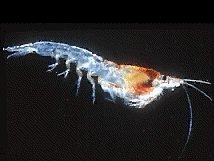
Classification
Antarctic Krill are tiny shrimp-like crustaceans.
Krill is a term used to describe about 85 species of open-ocean crustaceans
known as euphasids.
Appearance
Krill look like smaller versions of more
familiar crustaceans such as prawns or lobsters, and range in size from
small tropical species less than a centimeter long to little known deep-sea
giants that can reach lengths of up to 14 centimeters. All species have
a recognisable crustacean shape; that is, they have an elongated head-trunk
region (cephalothorax) and a muscular, segmented tail (abdomen) to which
are attached five pairs of paddle-like swimming legs.
Diet
Antarctic Krill are mainly herbivorous,
feeding on the phytoplankton (microscopic suspended plants) of the Southern
Ocean, though planktonic animals (zooplankton) may also form part of their
diet.
Development
Krill, like all crustaceans, grow by moulting;
that is, they cast off the old confining shell and expand in size while
the shell is still soft. What seems to be unique in krill is that is the
ability to use this process in reverse (in other words, to shrink) when
food is absent.
Breeding
In summer, female Antarctic krill lay
up to 10 000 eggs at a time, sometimes several times during a season, into
the surface waters of the Southern Ocean. The eggs are thought to sink
to a depth of 2000 metres before hatching. They then begin their long ‘developmental
ascent’ (up to 10 days), during which the newly hatched larvae journey
up towards the sunlit waters to feed.
Distribution
Antarctic krill (Euphasia superba) are
one of the most abundant and successful animal species on Earth.
Behavior
As Krill come to resemble adults they
begin to aggregate into huge schools or swarms; sometimes stretching for
kilometres in every direction, with many thousands of krill packed into
each cubic meter of water turning it red or orange. The first seamen who
ventured into waters round Antarctica were confused by discoloured patches
on the surface of the water. Captain Cook may even have mistaken one of
these patches for shallow water, leading him to suspect he was near land.
No one is quite sure how krill, old or
young, survive the Antarctic water. They do not seem to build up fat reserves,
so must either use some food available under the ice such as the algae
which grows on the underside of pack ice, detirus on the seafloor or the
other animals in the water or utilise some internal store other than fat.
